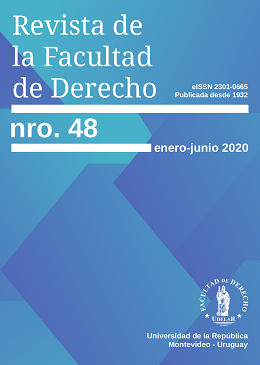Trapped Between Legal Systems:
Value of Precedent for the Inter-American Court of Human Rights
Abstract
This article seeks to determine whether the rulings of the Inter-American Court of Human Rights constitute primary or subsidiary sources of law. For that purpose the precedent system, characteristic of the Anglo-Saxon tradition, is contrasted with the way in which said tribunal rules. The article analyzes, first, how the precedent system works, focusing in the concept of stare decisis. Then a contrast between the way in which the Inter-American Court and the tribunals in the precedent system rule, is made, in order to determine why the Court in question refers in its decisions to its own jurisprudence. The analysis deals with this issue both from a theoretical and normative perspective, as well as from a case law and practical one. The states part of the Inter-American system should not be indiferent to the answer to the question presented in this paper, since they have surrender part of their sovereignty to a supranational institution, and understanding how it decides is the minimum than can be expected from it.
Downloads
References
Caminker, E. (1994). Precedent and Prediction: The Forward-Looking Aspects of Inferior Court Decision making. Texas Law Review, (73), 1-82.
Castilla, K. (2013). ¿Control Interno o Difuso de Convencionalidad? Una Mejor Idea: La Garantía de Tratados. Anuario Mexicano de Derecho International, (13), 51-97.
Cornes, R. (2013). Pérdidas y ganancias en la traducción. El Liderazgo del Tribunal Supremo del Reino Unido: parámetros y perspectivas (trad. L. Gordillo Pérez). Teoría y Realidad Constitucional, (31), 121-198.
Cueto, J. (1957). El “Common Law”. Buenos Aires: La Ley.
De Jesús, L. (2014). The Inter-American Court of Human Rights Judgement in Artavia Murillo v. Costa Rica and Its Implications for the Creation of Abortion Rights in the Inter-American System of Human Rights. Oregon Review of International Law, (16), 225-248.
Dunhoe, J. (2006). Jurisprudence Désorientée: The Louisiana Supreme Court’s Theory of Jurisprudential Valuation, Doerr v. Mobil Oil and Louisiana Electorate of Gays and Lesbians v. State. Louisiana Law Review, 64(3), 679- 698.
Faúndez, H. (2004). El sistema interamericano de protección de los Derechos Humanos: aspectos institucionales y procesales. San José (Costa Rica): Instituto Interamericano de Derechos Humanos.
Fuenzalida, S. (2015). La jurisprudencia de la Corte Interamericana de Derechos Humanos como fuente de derecho: Una revisión de la doctrina del “examen de convencionalidad”. Revista de derecho (Valdivia), 28(1), 171-192.
García, S. y Gonza, A. (2007). La libertad de expresión en la jurisprudencia de la Corte Interamericana de Derechos Humanos. México: s/editorial.
Garner B. A. (ed.) (1990). Black’s Law Dictionary. Minnesota: West, St. Paul.
Goodhart, A. (1930). Case Law in England and America. Cornell Law Quarterly, 15(2), 173-193.
Greenawalt, K. (2012). Statutory and Common Law Interpretation. Nueva York: Oxford Press University.
Iturralde, V. (1995). El precedente en el Common Law. Madrid: Civitas.
Jacob, M. (2011). Precedents: Lawmaking through International Adjudication. German Law Journal, 12(5), 1005–32.
Langbein, J. (1968). Modern jurisprudence in the House of Lords: The passing of London Tramways. Cornell Law Review, (52), 807-813.
Legarre, S. y Rivera, J. (2006). Naturaleza y Dimensiones del Stare Decisis. Revista Chilena de Derecho, 33(1), 109-124.
López, S. (2017). Un Derecho Jurisprudencial. La Propiedad Colectiva Y La Corte Interamericana. Revista de Derecho (Coquimbo), 24(1), 133-189.
Lupe, Y. y Voeten, E. (2012). Precedent in International Courts: A Network Analysis of Case Citations by the European Court of Human Rights. British Journal of Political Science, 24(2), 413-439.
Medina, C. y Nash, C. (2007). Sistema interamericano de Derechos Humanos: introducción a sus mecanismos de protección. Santiago de Chile: Universidad de Chile, Facultad de Derecho.
Miller, N. (2002). An International Jurisprudence? The Operation of ‘Precedent’ Across International Tribunals. Leiden Journal of International Law, (15), 483-526.
Mortimer, S. (2006). The doctrine of precedent in the United States of America.American Journal of Comparative Law, (54), 67-88.
Navarrete, J. (2004). Libertad de expresión en el sistema Americano. En Instituto Interamericano de Derechos Humanos (edit.), El sistema interamericano de protección de los Derechos Humanos: su jurisprudencia sobre debido proceso, DESC, libertad personal y libertad de expresión (pp. 241-282). San José (Costa Rica): Instituto Interamericano de Derechos Humanos.
Von Bogdandy, A. y Venzke, I. (2013). On the Functions of International Courts: An Appraisal in Light of Their Burgeoning Public Authority. Leiden Journal of International Law, 17(1), 49–72.
Pasqualucci, J. (2003). The practice and procedure of the Inter-American Court of Human Rights. Cambrige: Cambridge University Press.
Paúl, Á. (2013). La Corte Interamericana in vitro: comentarios sobre su proceso de toma de decisiones a propósito del caso Artavia. Derecho Público Iberoamericano, (2), 303-345.
Paúl, Á. (2013a). Giro en materia de recurso de revisión ante la Corte Interamericana. Revista Chilena de Derecho y Ciencia Política, 4(2), 131-138.
Paúl, Á. (2014). Decision-Making Process of the Inter-American Court: An Analysis Prompted by the ‘In Vitro Fertilization’ Case. ILSA Journal of International & Comparative Law, 21 (1), 87-130.
Paúl, Á. (2017). Rechazo de solicitudes de opinión consultiva por parte de la Corte Interamericana de Derechos Humanos. Revista chilena de derecho y ciencia política, 8(1), 191-131.
Paúl, Á. (2018). Cuatro extendidos desaciertos de la Corte Interamericana que se observan en su opinión consultiva n° 24. Anuario de Derecho Público, 2018, 203-226.
Rickett, C. (1980). Precedent in the Court of Appeal. Modern Law Review, (43), 138- 158.
Shahabuddin, M. (2007). Precedent in the World Court. Nueva York: Cambridge University Press.
Shaw, M. (2008). International Law. Nueva York: Cambridge University Press.
Tracol, X. (2004). The Precedent of Appeals Chambers Decisions in the International Criminal Tribunals. Leiden Journal of International Law, (17), 67-102.
Venzke, I. (2012). Role of International Courts as Interpreters and Developers of the Law: Working out the Jurisgenerative Practice of Interpretation. Loyola of Los Angeles International and Comparative Law Review, 34(1), 99-131.
Von, V. y Parisi, F. (2006). Judicial precedents in civil law systems: A dynamic analysis. International Review of Law and Economics, (26), 519-535.
Whittaker, S. (2008). El precedente en el derecho inglés: una visión desde la ciudadela (trad. C. Banfi del Río). Revista Chilena de Derecho, 35(1), 37-83.
Copyright (c) 2020 María Elisa Zavala Achurra

This work is licensed under a Creative Commons Attribution 4.0 International License.
This journal provides open access to its content, based on the principle that providing the public with free access to research helps a greater global exchange of knowledge
Revista de la Facultad de Derecho. Creative Commons Reconocimiento 4.0 Internacional License.










